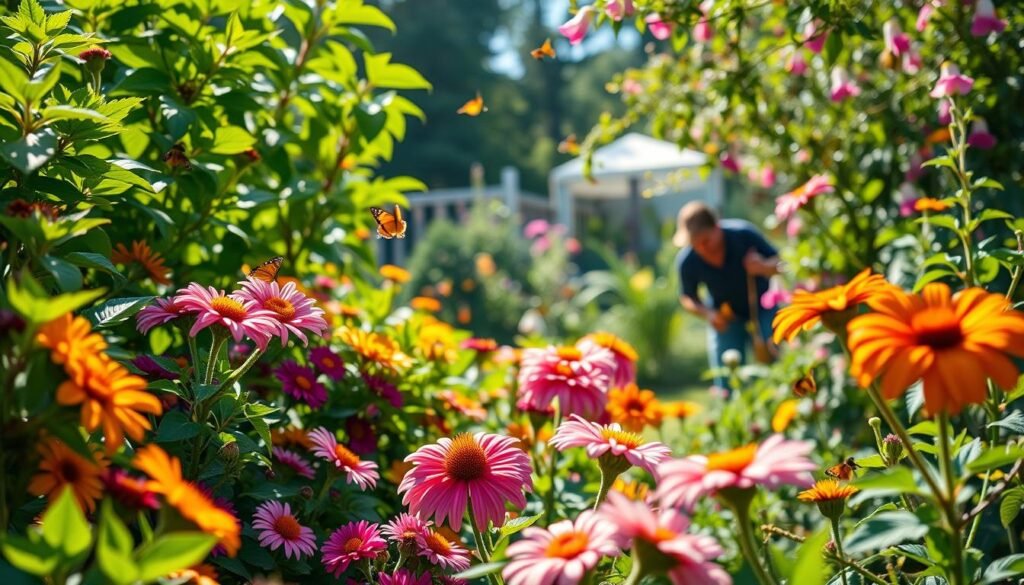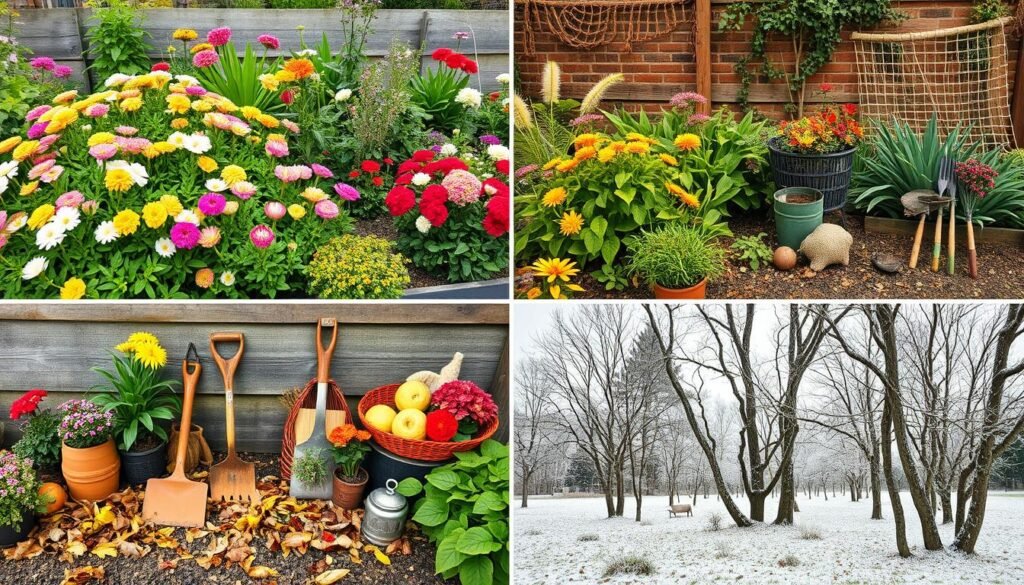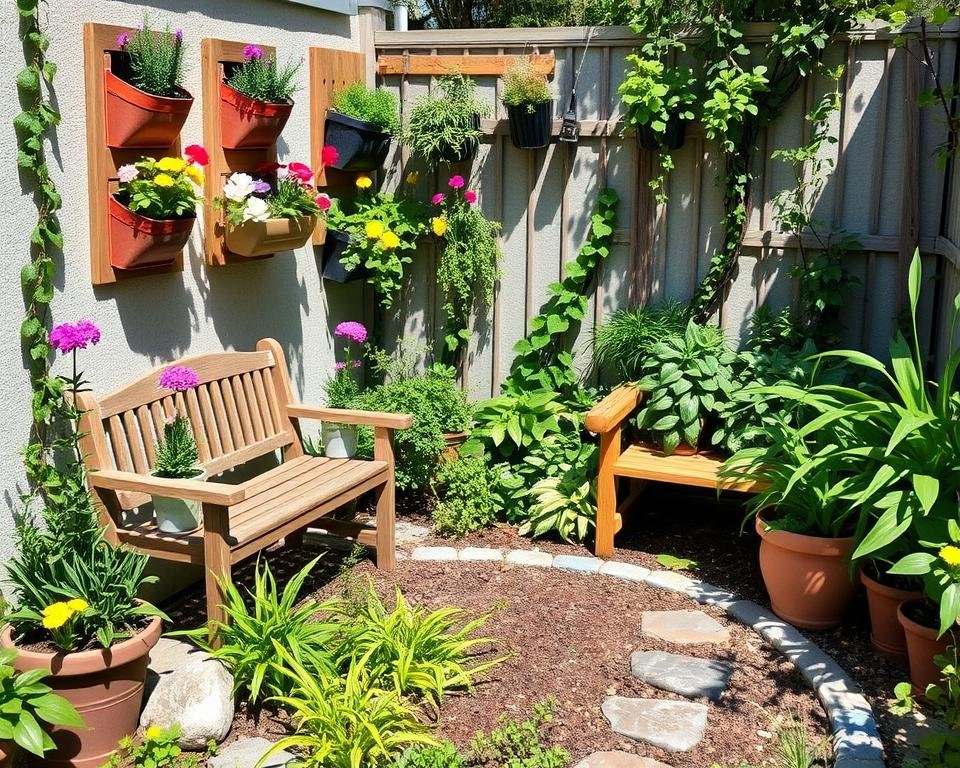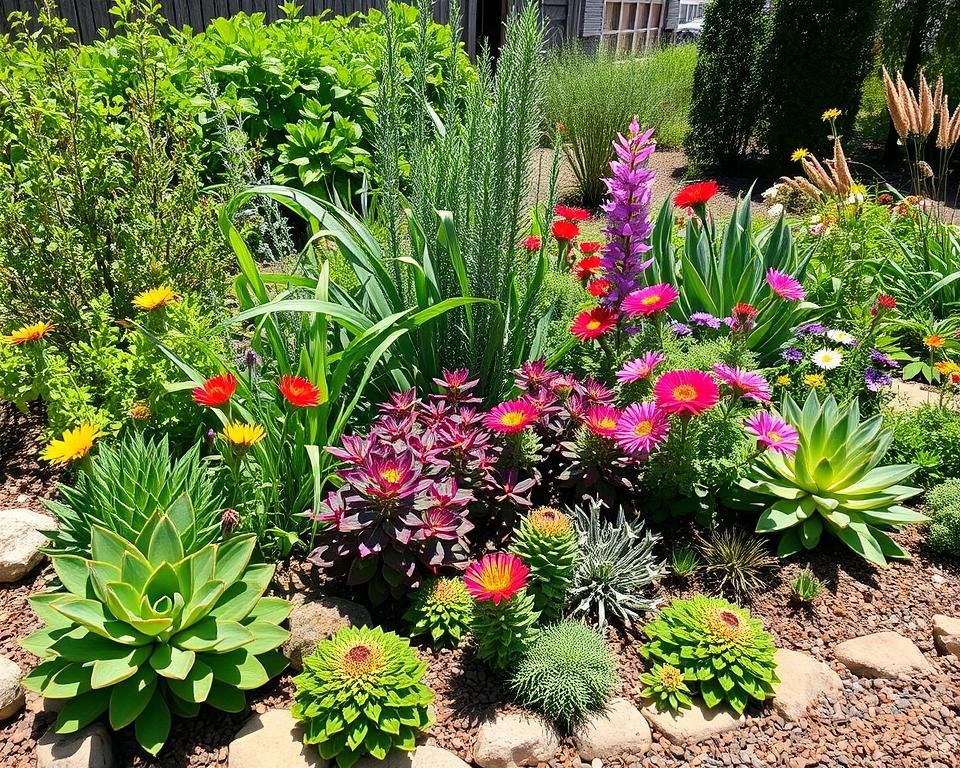Ever ponder why some gardens flourish through every season, while others falter? The answer lies in mastering the art of year-round gardening. By grasping the distinct challenges and opportunities each season brings, you can turn your yard into a lush, vibrant oasis. Garden maintenance tips change with the seasons, from spring’s gentle awakening to summer’s blooms, fall’s preparations, and winter’s protective measures. Are you ready to uncover the secrets of seasonal garden care? Let’s explore!
Spring Garden Care: Awakening Your Yard
Spring marks a critical period to revitalize your garden post-winter. A well-planned approach is key to ensuring your yard thrives. We’ll explore crucial steps in our spring gardening guide to get your garden blooming.
Preparing the Soil
Soil preparation is the cornerstone of a thriving garden. Start by adding compost or organic matter to replenish lost nutrients. This step is crucial for fostering a fertile ground for new growth. Next, test your soil’s pH levels and adjust them to meet your plants’ needs.
Planting Early-Blooming Flowers
Early-blooming flowers add a burst of color and joy to your garden. Plant daffodils, crocuses, or tulips in the fresh spring soil. These flowers not only enhance your garden’s beauty but also attract pollinators, boosting your garden’s health.
Pruning and Trimming Shrubs
Pruning and trimming are vital for promoting healthy growth in shrubs and trees. Remove dead or damaged branches to foster new growth and improve air circulation. Regular pruning maintains plant shape and encourages blooming, resulting in a lush, organized garden.
Pest Control Strategies for Spring
Effective pest control is essential in any spring gardening guide. Protect your young plants from pests like aphids, slugs, and caterpillars. Employ natural deterrents like neem oil or introduce beneficial insects that prey on pests. Regularly check your plants for signs of infestation and act quickly to prevent damage.
| Task | Description |
|---|---|
| Soil Preparation | Enrich with compost, test pH levels, adjust nutrients. |
| Planting Early-Blooming Flowers | Choose daffodils, crocus, tulips for a vibrant start. |
| Pruning and Trimming | Remove dead branches, shape plants, improve air circulation. |
| Pest Control | Natural deterrents, beneficial insects, regular inspections. |
Summer Garden Care: Keeping Your Yard Thriving
As summer arrives, it’s vital to adopt effective strategies for garden upkeep. This ensures your yard remains vibrant and healthy. Proper watering and mulching are key to maintaining your garden’s vitality.

Watering Efficiently
Efficient watering is crucial for summer garden care. Watering in the early morning is best, as it cools the soil and reduces evaporation. This allows plants to absorb moisture better. Consider drip irrigation or soaker hoses to save water and ensure plants get enough.
- Water early in the morning to reduce evaporation.
- Use drip irrigation or soaker hoses for targeted watering.
- Check soil moisture levels regularly to avoid overwatering.
Mulching to Retain Soil Moisture
Mulching is essential for retaining soil moisture and regulating temperature. Apply organic mulch, such as straw, wood chips, or compost, around your plants. This creates a protective barrier, keeping the soil cool and suppressing weeds. It also improves soil health.
- Use organic mulches like straw, wood chips, or compost.
- Apply mulch around plants to regulate soil temperature.
- Replenish mulch as needed to maintain its effectiveness.
By focusing on efficient watering and the benefits of mulching, your garden will thrive all summer. Your efforts will pay off with a beautiful, vibrant yard.
A guide to maintaining your garden throughout the different seasons, including seasonal care and tips
Successful gardening demands a year-round commitment to plant health and garden beauty. This guide will help you manage seasonal changes, ensuring your garden flourishes all year.

In the spring, your garden comes back to life. This is the time to ready the soil, plant early flowers, prune shrubs, and fight pests.
- Prepare the soil by tilling and adding organic compost.
- Plant bulbs and early-blooming flowers.
- Prune dead branches and trim back overgrowth.
- Implement pest control to prevent infestations.
Summer is about keeping plants hydrated and the soil moist. Efficient watering and mulching are key to comprehensive garden care.
- Water deeply and less frequently to promote root growth.
- Use mulch to retain soil moisture and suppress weeds.
As fall arrives, prepare your garden for the cold. Protect delicate plants and plant hardy perennials to strengthen your garden for winter.
Winter doesn’t mean the end of gardening. Protect your garden and plan for next year. Cover exposed soil, prune deciduous trees, and plan your garden’s layout for the coming season.
| Season | Key Activities |
|---|---|
| Spring | Soil Preparation, Early Planting, Pruning, Pest Control |
| Summer | Efficient Watering, Mulching |
| Fall | Winter Preparation, Planting Perennials |
| Winter | Garden Protection, Planning |
Use this guide to keep your garden vibrant and healthy all year. The key to comprehensive garden care is understanding and adapting to each season’s needs.
Fall Garden Care: Preparing for the Cold
As the cooler months approach, it’s vital to undertake critical fall gardening tasks that will ensure your yard remains healthy and thriving. One essential aspect of autumn garden preparation is removing spent annuals. These plants have completed their lifecycle and should be cleared to create space for new growth.
Planting fall crops or bulbs is another key task. This preparation will not only provide beautiful spring flowers but also offer a harvest of fresh produce in the cooler months. Choose hardy varieties that can withstand the early frosts, such as tulips and garlic, for a vibrant garden come spring.

Protecting perennials and sensitive plants from impending frosts is essential. Mulching around the base of perennials can help insulate the roots, while placing covers over more delicate plants can provide much-needed protection. This step will safeguard your plants from frost damage and help them return robustly in spring.
Soil maintenance is another crucial component of autumn garden preparation. Adding organic matter like compost or manure will enhance soil structure and fertility, preparing it for the next growing season. Healthy soil is foundational for any successful garden, ensuring that plants are well-nourished and ready to flourish.
- Remove spent annuals
- Plant fall crops or bulbs
- Protect perennials from frost
- Enhance soil with organic matter
Engaging in these fall gardening tasks not only secures your garden’s beauty and bounty but also sets the stage for a vibrant and healthy yard year-round. By addressing these essential tasks, you’ll be well-prepared for the colder months, ensuring that your garden thrives once spring arrives.
Winter Garden Care: Protecting and Planning
Winter garden care extends beyond the first frost. Proper protection and engaging in off-season activities are key for a thriving garden in spring. It’s vital to protect plants from frost, manage winter weeds, and care for non-dormant plants during the cold months.
- Protecting against frost: Use burlap or frost blankets to cover delicate plants, providing insulation from freezing temperatures.
- Managing winter weeds: Regularly inspect your garden and remove any weeds to prevent them from taking over once the weather warms up.
- Non-dormant plant care: Ensure that evergreen shrubs and perennials receive adequate water to avoid winter desiccation.

The winter season is perfect for planning and restorative gardening. Consider drafting a garden plan for spring, deciding on new plant varieties, and identifying areas for improvement. Winter pruning of dormant trees and shrubs encourages healthy growth and shapes the plants for the upcoming season.
- Drafting a spring garden plan: Outline where you will plant new flowers or vegetables, and research suitable varieties for your region.
- Winter pruning: Trim dead or diseased branches from trees and shrubs to boost their resilience and promote new growth.
- Soil improvement: Add compost or organic matter to your garden beds to enrich the soil for spring planting.
These off-season gardening activities lay a solid foundation for your garden’s future success. Embracing winter garden protection and planning ensures your garden remains healthy and productive all year.
Year-Round Gardening Activities for Continuous Enjoyment
Garden enthusiasts can delight in continuous gardening by engaging in a variety of activities that sustain their green passions year-round. All-season garden enjoyment is not just limited to perfect spring days; it can span across all months with the right strategies. Here are several ideas to keep you connected to your yard throughout the entire year:
- Indoor Gardening Projects: Embrace indoor gardening during the colder months. Grow herbs on your kitchen windowsill or start a succulent collection. Not only do these projects keep your green thumb busy, but they also bring life into your home.
- Maintenance of Garden Tools: Take this time to clean, sharpen, and repair your gardening tools. Well-maintained tools are crucial for continuous gardening and ensure they are ready for the next gardening season.
- Engaging in Garden Design: Winter is an excellent time to plan your garden design for the upcoming year. Create sketches, select plants, and plan new features for your garden. This anticipation adds to the all-season garden enjoyment and keeps your creativity flowing.
- Growing Cold-Hardy Plants: Incorporate cold-hardy plants like pansies, ornamental cabbages, and evergreens into your garden. These plants add vibrancy and interest during winter, allowing you to enjoy the beauty of your garden even in the cold months.

Continuously engaging in these activities not only fills your days with garden-related tasks but also fosters a deeper connection to your outdoor space, no matter what season it is. With these ideas, you can achieve true all-season garden enjoyment and cherish the continuous gardening lifestyle.
| Activity | Beneficial Season | Description |
|---|---|---|
| Indoor Gardening | Winter | Grow herbs and succulents indoors to keep your green thumb active. |
| Tool Maintenance | Winter | Clean, sharpen, and repair garden tools for optimal performance. |
| Garden Design | Winter | Plan and sketch your garden layout for the coming seasons. |
| Cold-Hardy Plants | Winter | Incorporate plants that thrive in cold weather for winter color. |
Conclusion
Reflecting on your journey through seasonal garden care, it’s clear that maintaining a healthy garden year-round requires dedication and adaptability. Starting with the rejuvenation of spring, where preparing the soil, planting early-blooming flowers, and addressing early pests set the foundation for a thriving garden. Moving into summer, watering efficiently and using mulch to retain soil moisture are key practices to keep your yard vibrant amidst the heat.
Fall brings its own set of tasks, such as preparing garden beds for the impending cold, ensuring your yard remains protected through winter. Winter care is all about safeguarding your plants from harsh conditions and planning for the seasons to come. Year-round gardening activities not only provide continuous enjoyment but also ensure your garden remains a dynamic and rewarding space.
Embracing each season as an opportunity for growth and renewal instills a sense of preparedness and enthusiasm. The cyclical nature of gardening reminds us that every season brings new challenges and rewards. By engaging in these practices, you’ll achieve successful gardening year-round and witness your garden’s beauty and health flourish continuously. So, gear up for each season with confidence and relish in the journey of maintaining a plant paradise around your home.
FAQ
What are the key tasks for garden maintenance throughout the year?
Year-round gardening requires different tasks for each season. In spring, focus on soil preparation and planting early-blooming flowers. Summer demands efficient watering and mulching. Fall is for preparing the garden for winter by removing spent annuals and planting fall crops. Winter involves protecting plants and planning for spring. Each season has unique care needs to maintain a healthy, vibrant garden.
How can I prepare my soil for spring gardening?
Soil preparation in spring is essential for successful gardening. Begin by clearing any debris left from winter. Add compost or organic matter to enhance soil fertility. Test the soil pH and adjust as needed. This ensures your plants have a nutrient-rich environment to thrive.
Which flowers are best to plant in early spring?
Early-blooming flowers like tulips, daffodils, crocuses, and hyacinths are ideal for spring. These flowers add color to your garden and thrive in cooler temperatures. They provide early-season joy and vibrancy.
What are some efficient watering techniques for summer?
Efficient watering is crucial in the hot summer months. Water in the early morning to reduce evaporation and fungal growth. Use drip irrigation or soaker hoses to conserve water and ensure it reaches the roots. Mulching also helps retain soil moisture and reduces watering needs.
How does mulching benefit my garden in summer?
Mulching offers several benefits in summer. It retains soil moisture, reducing watering needs. Mulch also regulates soil temperature, keeping roots cool. It suppresses weed growth and adds organic matter to the soil as it decomposes.
What tasks are essential for fall garden preparation?
Fall garden care includes several key tasks. Remove spent annuals and plant fall crops or bulbs. Protect perennials and sensitive plants from frosts by covering them or moving them indoors. Prepare the soil by adding compost and mulch, and clean up garden debris to prevent pests and diseases.
How can I protect my garden during the winter?
Protecting your garden in winter involves several strategies. Use mulch to insulate plant roots and prevent soil erosion. Cover delicate plants with frost cloths or bring them indoors. Prune dormant trees and shrubs to encourage healthy growth in the spring. Winter is also a good time for planning next season’s garden layout and tasks.
What are some gardening activities I can enjoy year-round?
Gardening can be enjoyed year-round. Indoor gardening projects like growing herbs or houseplants are great during colder months. Maintain and sharpen your garden tools in the off-season. Plan and design your garden for upcoming seasons. You can also grow cold-hardy plants to keep your garden lively throughout the year.

